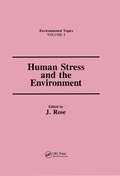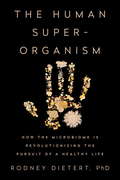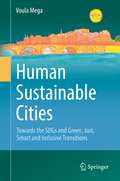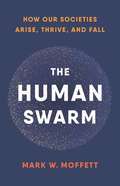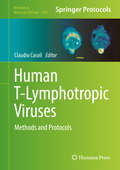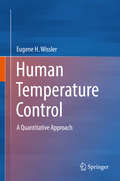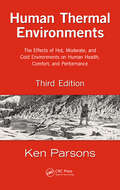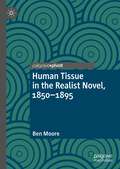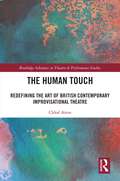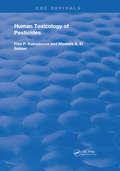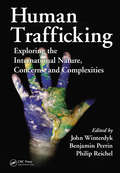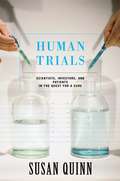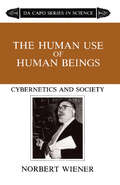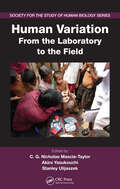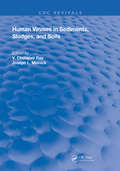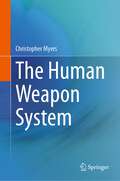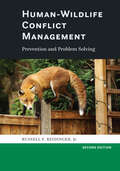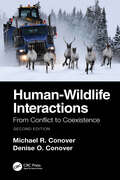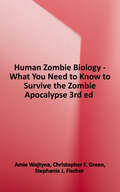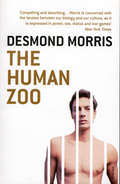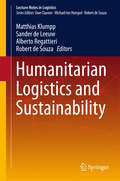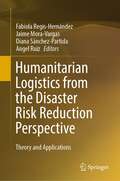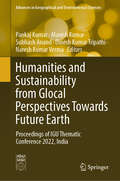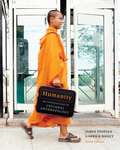- Table View
- List View
Human Stress and the Environment
by Allen H. RoseFirst published in 1994. This volume is devoted to a study of the relationship between stress and health. The aim of this work is to present an account of this complex and difficult problem, without the sensationalism often associated with modern environmental remedies.
The Human Superorganism: How the Microbiome Is Revolutionizing the Pursuit of a Healthy Life
by Rodney Dietert"Eyeopening... Fascinating... may presage a paradigm shift in medicine." --Kirkus Reviews (starred review)"Teeming with information and big ideas... Outstanding."--Booklist (starred review)The origin of asthma, autism, Alzheimer's, allergies, cancer, heart disease, obesity, and even some kinds of depression is now clear. Award-winning researcher on the microbiome, professor Rodney Dietert presents a new paradigm in human biology that has emerged in the midst of the ongoing global epidemic of noncommunicable diseases. The Human Superorganism makes a sweeping, paradigm-shifting argument. It demolishes two fundamental beliefs that have blinkered all medical thinking until very recently: 1) Humans are better off as pure organisms free of foreign microbes; and 2) the human genome is the key to future medical advances. The microorganisms that we have sought to eliminate have been there for centuries supporting our ancestors. They comprise as much as 90 percent of the cells in and on our bodies--a staggering percentage! More than a thousand species of them live inside us, on our skin, and on our very eyelashes. Yet we have now significantly reduced their power and in doing so have sparked an epidemic of noncommunicable diseases--which now account for 63 percent of all human deaths. Ultimately, this book is not just about microbes; it is about a different way to view humans. The story that Dietert tells of where the new biology comes from, how it works, and the ways in which it affects your life is fascinating, authoritative, and revolutionary. Dietert identifies foods that best serve you, the superorganism; not new fad foods but ancient foods that have made sense for millennia. He explains protective measures against unsafe chemicals and drugs. He offers an empowering self-care guide and the blueprint for a revolution in public health. We are not what we have been taught. Each of us is a superorganism. The best path to a healthy life is through recognizing that profound truth.From the Hardcover edition.
Human Sustainable Cities: Towards the SDGs and Green, Just, Smart and Inclusive Transitions
by Voula MegaThis book argues that accelerating action toward sustainability for and by cities and their inhabitants can make a huge difference to humanity’s endeavor to recover from current crises and build a sustainable future. It sheds light on cutting-edge concepts and actions toward sustainability that can taken by and for cities and with citizens. In this book, author Voula Mega takes the reader on a journey inside and across cities and highlights efforts toward a paradigmatic shift that reconciles human systems with nature. Leadership, education, innovation, trust and citizen empowerment all play a crucial role for the co-invention of a new model that balances human well-being, sustainable prosperity and the future of the planet. Building on robust evidence and inspired by best practices, Human Sustainable Cities offers compelling messages and convincing advice to all stakeholders who are striving to overcome crises, speed up the path toward resilience and preparedness and bounce forward better.
The Human Swarm: How Our Societies Arise, Thrive, and Fall
by Mark W. MoffettThe epic story and ultimate big history of how human society evolved from intimate chimp communities into the sprawling civilizations of a world-dominating species <P><P>If a chimpanzee ventures into the territory of a different group, it will almost certainly be killed. But a New Yorker can fly to Los Angeles--or Borneo--with very little fear. <P><P>Psychologists have done little to explain this: for years, they have held that our biology puts a hard upper limit--about 150 people--on the size of our social groups. But human societies are in fact vastly larger. How do we manage--by and large--to get along with each other? <P><P>In this paradigm-shattering book, biologist Mark W. Moffett draws on findings in psychology, sociology and anthropology to explain the social adaptations that bind societies. He explores how the tension between identity and anonymity defines how societies develop, function, and fail. <P><P>Surpassing Guns, Germs, and Steel and Sapiens, The Human Swarm reveals how mankind created sprawling civilizations of unrivaled complexity--and what it will take to sustain them.
Human Systems Interactions: FOSS Science Resources
by Lawrence Hall of Science University of California at BerkeleyNIMAC-sourced textbook
Human T-Lymphotropic Viruses
by Claudio CasoliWhile HIV-1 continues to be well-researched, this detailed volume draws attention to other members of the Retrovirus family, namely the Human T-lymphotropic Viruses (HTLVs), featuring the most updated technical information about HTLV determination and the methods to investigate their interaction with the host immune system and interfering pathogens. The contents include essential aspects of epidemiology and virus transmission, novel and robust methodologies for studying the effects of trans-activating regulatory HTLVs' proteins, the latest techniques for genotyping and gene expression analysis, as well as cellular phenotype and dynamics. Written in the highly successful Methods in Molecular Biology series format, chapters include introductions to their respective topics, lists of the necessary materials and reagents, step-by-step, readily reproducible laboratory protocols, and tips on troubleshooting and avoiding known pitfalls. Authoritative and practical, Human T-Lymphotropic Viruses: Methods and Protocols serves as an ideal guide to an area of study that is very much worthy of further research.
Human Temperature Control: A Quantitative Approach
by Eugene H. WisslerThe principal objective of this book is to provide information needed to define human thermal behavior quantitatively. Human thermal physiology is defined using mathematical methods routinely employed by physicists and engineers, but seldom used by physiologists. Major sections of the book are devoted to blood flow, sweating, shivering, heat transfer within the body, and heat and mass transfer from skin and clothing to the environment. Simple algebraic models based on experimental data from a century of physiological investigation are developed for bodily processes. The book offers an invaluable source of information for physiologists and physical scientists interested in quantitative approaches to the fascinating field of human thermoregulation.
Human Thermal Environments: The Effects of Hot, Moderate, and Cold Environments on Human Health, Comfort, and Performance, Third Edition
by Ken ParsonsIn the ten years since the publication of the second edition of Human Thermal Environments: The Effects of Hot, Moderate, and Cold Environments on Human Health, Comfort, and Performance, Third Edition, the world has embraced electronic communications, making international collaboration almost instantaneous and global. However, there is still a need
Human Tissue in the Realist Novel, 1850-1895 (Palgrave Studies in Literature, Science and Medicine)
by Ben MooreThis Pivot engages with current debates about anthropocentrism and the Anthropocene to propose a reappraisal of the realist novel in the second half of the nineteenth century. Through three case studies, it argues for ‘human tissue’ as a conceptual tool for reading that brings together biology, literature and questions of layering. This new approach is shown to be especially salient to the Victorian period, when the application of ‘tissue’ to biology first emerges. The book is distinctive in bringing together theoretical concerns around realism and the Anthropocene – two major topics in literary criticism – and presenting a new methodology to approach this conjunction, demonstrated through original readings of Charles Kingsley, George Eliot, and Emile Zola and two English-language writers he influenced (George Moore and Vernon Lee).
The Human Touch: Redefining the Art of British Contemporary Improvisational Theatre (ISSN)
by Chloé ArrosThe Human Touch is a book focused on the creative processes at work in British contemporary improvisational theatre and how these processes draw on the humanity of the participants: their cognitive abilities, their lives, and their relationships to each other. Vulnerability is a main feature of both the book and of improvisational theatre, both part of the hurdles that improvisers face and a creative tool. Through a study of improvisation and vulnerability, the book teaches us both what makes improvisational theatre so human and opens the door to a reflection about how to use humanity and human emotions in performance. Most importantly, it delves into the cognitive and physiological processes at work in improvisation, a topic which is missing from most manuals and studies offered to students. This book is addressed to theatre students and provides both an important overview of the form’s history and a challenge to what is usually taught about improvisation.
Human Toxicology of Pesticides (Routledge Revivals)
by Fina P. Kaloyanova M. A. El BatawiFirst Published in 1991, this book conducts a systematic analysis of existing information regarding the toxicological effects of pesticides on humans. The book identifies the negative health effects related to exposure to pesticides and the biological changes required to undertake biological monitoring. The book also discusses the importance and magnitude of the problem for different kinds of pesticide applications in different parts of the world, explains the toxicodynamics and clinical picture of acute and chronic intoxications resulting from exposure to different groups of pesticides and selected individual substances, and evaluates existing methods and limitations for assessing human exposure to pesticides. Pesticide manufacturers, occupational health professionals, epidemiologists, environmentalists, government agencies and others concerned with the effects of pesticides on human populations should consider this book essential reading.
Human Trafficking: Exploring the International Nature, Concerns, and Complexities
by Benjamin Perrin John Winterdyk Philip ReichelHuman trafficking is a crime that undermines fundamental human rights and a broader sense of global order. It is an atrocity that transcends borders with some regions known as exporters of trafficking victims and others recognized as destination countries. Edited by three global experts and composed of the work of an esteemed panel of contributors,
Human Trials: Scientists, Investors, And Patients In The Quest For A Cure
by Susan QuinnSusan Quinn's extraordinary story takes the reader into the closed world of experimental "human trials" in which new drugs are developed. Both the portrait of a dedicated scientist and the archetypal story of all medical research, Human Trials is the emotion-laden, roller-coaster trip from the lab bench to the medicine cabinet, in which scientists risk their reputations, venture capitalists their millions, and patients their very lives. A Merloyd Lawrence Book
The Human Use Of Human Beings: Cybernetics And Society
by Norbert WienerOnly a few books stand as landmarks in social and scientific upheaval. Norbert Wiener's classic is one in that small company. Founder of the science of cybernetics?the study of the relationship betwee
Human Variation: From the Laboratory to the Field (Society for the Study of Human Biology)
by C. G. Nicholas Mascie-Taylor Akira Yasukouchi Stanley UlijaszekThe transition in anthropological and biomedical research methods over the past 50 years, from anthropometric and craniometric measurements to large-scale microarray genetic studies has resulted in continued revision of opinions and ideas relating to the factors and forces that drive human variation. Human Variation:From the Laboratory to the Field
Human Viruses In Sediments Sludges & Soils (Routledge Revivals)
by V. Chalapati Rao Joseph L. MelnickFirst published in 1991, this book conducts a systematic analysis of information regarding the viral effects of sediments, sludges, and soils on humans. Industrial manufacturers, health professionals, governmental agencies and others concerned with the effects of chemical waste on human populations should consider this book essential reading.
The Human Weapon System
by Christopher MyersThis book discusses the differences between a human weapon system and a tactical athlete and what a human optimization program is. Furthermore, this book discusses and demonstrates how to put together a training program at an organizational level for the human weapon system. A systematic approach is presented and discussed, from initial analysis of the human weapon system to creating a multi-domain human performance optimization program. This book strives to familiarize the reader with the systematic approach that the author has utilized as an exercise physiologist in the Department of Defence over the past ten years. This book also explains how to utilize technology to individualize the human performance optimization program at an organizational level. The book discusses current technologies in power generation, measuring endurance, and nutrition, and also demonstrates to strength coaches and practitioners how to use these technologies and individualize optimization.
Human-Wildlife Conflict Management: Prevention and Problem Solving
by Russell F. Reidinger Jr.The latest edition of this classic guide details how to understand and resolve a broad array of human-wildlife conflicts.This new edition of Human-Wildlife Conflict Management updates our understanding of the human dimensions, as well as biological and ecological concepts, underlying human-wildlife conflicts. While it provides wildlife professionals and students with the knowledge and adaptive management strategies to resolve such conflicts, it uniquely explores negative interactions with a wide range of wildlife taxa beyond those typically covered in traditional wildlife damage management, including invasive plants, invertebrates, and fish.Designed to help students and natural resource practitioners gain a deeper understanding of how to successfully avoid and resolve conflict between humans and wildlife, it is informed by author Russell F. Reidinger's decades of teaching students and professionals how to anticipate and manage human-wildlife conflicts, as well as his experience leading a national research program devoted to this work.The book covers important human-wildlife topics such as:• individual-, population-, and ecosystem-level effects• survey techniques• management methods• human dimensions• economic issues• legal and political aspects• damage management strategiesFeaturing explanations of important terminology and pertinent biological and ecological concepts, Reidinger also shares the latest research, provides a plethora of real-world examples, and includes suggestions for additional resources.
Human-Wildlife Interactions: From Conflict to Coexistence
by Michael R. Conover Denise O. ConoverThis book won the 2023 The Wildlife Society Publication Award in the authored book category. Human-wildlife interactions increase exponentially as more and more humans and wildlife crowd into the same limited space. Such interactions often become conflicts when wildlife threaten human health and safety, well-being, or the food supply. This second edition of Human-Wildlife Interactions: From Conflict to Coexistence provides a comprehensive review of the severity of these problems and the methods used to resolve clashes between humans and wildlife. During his forty-year career as a wildlife professor and scientist, Dr. Michael Conover, founder of journal Human-Wildlife Interactions, has become a recognized leader of the scientific field of human-wildlife interactions. In this book, he presents the range of methods for wildlife damage management, including employing lethal methods; distributing supplemental food; changing the behavior of either humans or wildlife; and excluding or repelling wildlife. Backed by numerous case studies and informative side bars, the book documents resolutions to specific human-wildlife conflicts throughout the literature. Containing full color illustrations throughout, the second edition of Human-Wildlife Interactions: From Conflict to Coexistence provides authoritative coverage and depth of both theoretical and practical information. It serves as an invaluable resource for students, researchers, and professional wildlife managers. Disclaimer: Figure 7.7 (b) on page 251 was incorrectly attributed in previous printings. The photographer of figure 7.7 (b) is Cynthia Herrick.
Human Zombie Biology: What You Need to Know to Survive the Zombie Apocalypse, Third Edition
by Amie Wojtyna Christopher F. Green Stephanie J. FischerZombies aren’t real. To our knowledge, there are no secret government laboratories working on creating or defeating the zombie menace, but if such laboratories are ever created, then sign us up to be the earth’s last, best hope. Human Zombie Biology provides students the knowledge to gain a greater understanding of the concepts of biology as they apply to zombies. The Centers for Disease Control and Prevention (CDC) has even used zombies to educate the American Public on how to be prepared for any emergency, using the philosophy that if you are prepared for the zombies, you are certainly prepared for whatever Mother Nature may throw at you. It is in this spirit that we offer you this book; what better way to learn the concepts of Biology than by using our friend the zombie? Think you don’t use biology? Think again. Every time you take a deep sniff of air to determine if there is a decaying zombie nearby-- or, slightly more likely, to determine if the old take-out food in the back of your fridge is safe to eat it―then you are using biology. Since people have started talking and then writing about zombies these stories have been a reflection of society, and have drawn upon scientific knowledge to make the stores as realistic as possible. So realistic are these stories that they make for excellent educational tools as they both grab your attention and can impart knowledge. Included with your eBook purchase, you will also receive access to KHQ, Kendall Hunt’s exclusive custom study app. Designed for today’s fast-paced environment, KHQ features chapter quizzes and flashcards that empower students to learn on the go!
The Human Zoo
by Desmond MorrisA must-read for anyone who has ever wondered why people do what they do, from the popular author of The Naked Ape.This study concerns the city dweller. Morris finds remarkable similarities with captive zoo animals and looks closely at the aggressive, sexual and parental behaviour of the human species under the stresses and pressures of urban living.‘Compelling and absorbing...Morris is concerned with the tension between our biology and our culture, as it is expressed in power, sex, status and war games’ New York Times
Humanitarian Logistics and Sustainability
by Matthias Klumpp Sander Leeuw Alberto Regattieri Robert SouzaThis contributed volume combines conceptual and strategic research articles dealing with the "why" and "to what end" of sustainable operations in humanitarian logistics, as well as operational research contributions regarding the "how" from the United Nations as well as from researchers and organizations from different countries (Germany, Australia, Singapore, Netherlands, Italy, Denmark, Jordan). The target audience primarily comprises research experts, decision makers and practitioners in the field, but the book may also be beneficial for graduate students.
Humanitarian Logistics from the Disaster Risk Reduction Perspective: Theory and Applications
by Angel Ruiz Diana Sánchez-Partida Fabiola Regis-Hernández Jaime Mora-VargasThis book aims to clarify the priorities of the Sendai Framework for the DRR 2015 – 2030, through gathering recent contributions addressing the different ways researchers define, measure, reduce, and manage risk in the challenge of the DRR. Beyond a discussion of the different definitions of disaster risk; this book provides contributions focused on optimization approaches that support the decision-making process in the challenge of managing DRR problems considering emerging disaster risks in the medium and long term, as well as national and local applications. Some of the topics covered include network flow problems, stochastic optimization, discrete optimization, multi-objective programming, approximation techniques, and heuristic approaches.The target audience of the book includes professionals who work in Linear Programming, Logistics, Optimization (Mathematical, Robust, Stochastic), Management Science, Mathematical Programming, Networks, Scheduling, Simulation, Supply Chain Management, Sustainability, and similar areas. It can be useful for researchers, academics, graduate students, and anyone else doing research in the field
Humanities and Sustainability from Glocal Perspectives Towards Future Earth: Proceedings of IGU Thematic Conference 2022, India (Advances in Geographical and Environmental Sciences)
by Pankaj Kumar Manish Kumar Subhash Anand Dinesh Kumar Tripathi Naresh Kumar VermaThis book presents selected papers from the International Geographical Union (IGU) Thematic Conference 2022, which was held at the Central University of Haryana, Mahendragarh, India, November 24–25, 2022. The theme of the conference was Sustainability, Future Earth, and Humanities: Opportunities and Challenges. Focusing on the humanities, the book shares advanced research and innovative approaches that illuminate significant discoveries concerning integrated glocal (global-local) perspectives on sustainability. The integration of humanities and glocal perspectives has become crucial to ensure a sustainable future for our planet. To achieve a thriving future, it is essential to bridge the gap between scientific knowledge and human values, while acknowledging the interconnectedness of local and global dynamics. The humanities contribute a distinct dimension to sustainability by offering cultural, ethical, and historical insights. Glocal perspectives, on the other hand, underscore the interdependence of our planet's ecosystems and human societies. They advocate for a dual focus on local contexts and global implications, recognizing that environmental challenges such as climate change, deforestation, loss of biodiversity, and pollution manifest differently in various regions due to diverse socio-economic, political, and cultural factors. The integration of the humanities and sustainability encourages a transformative shift towards more ethical and responsible behavior, fostering a sense of stewardship for the environment. The book includes a wide range of topics, focusing extensively on the potential contributions of humanities towards the goal of long-term sustainability. The topics covered in this book encompass in-depth analyses of various subjects, such as environment and society, social dynamics, human development, urban landscape dynamics, rural-urban inequality, gender inequality, gender-environment relationships, entrepreneurship, public health, COVID-19 management and its spatiotemporal aspects, and geopolitics, among others. The book discusses both global and local perspectives on these important issues. Consequently, the knowledge and innovation presented in the book make a substantial academic contribution and facilitate to achieve sustainability, both at local and global levels.
Humanity: An Introduction to Cultural Anthropology (9th Edition)
by James Peoples Garrick BaileyUsing engaging stories and clear writing, CENGAGE ADVANTAGE BOOKS: HUMANITY: AN INTRODUCTION TO CULTURAL ANTHROPOLOGY, Ninth Edition, introduces cultural anthropology within a solid framework centered on globalization and culture change. Peoples and Bailey focus on the social and cultural consequences of globalization, emphasizing culture change and world problems. The book's engaging narrative provides new ways of looking at many of the challenges facing the world in this century. As you explore more contemporary issues, including recent debates on gay marriage, cultural and economic globalization, population growth, hunger, and the survival of indigenous cultures, you will gain a better understanding of the cultural information you need to successfully navigate in today's global economy. The authors emphasize the diversity of humanity and reveal why an appreciation and tolerance of cultural differences is critical in the modern world.
